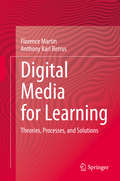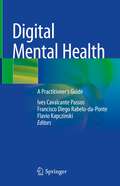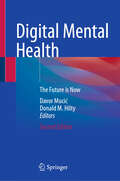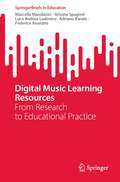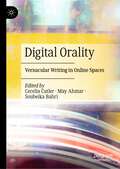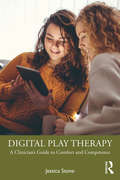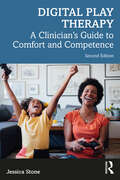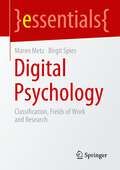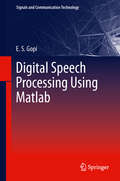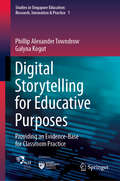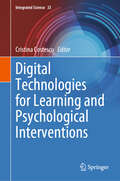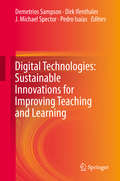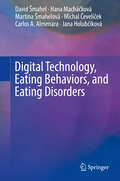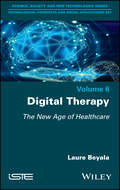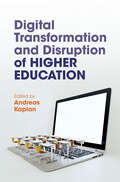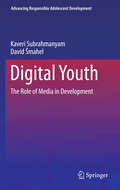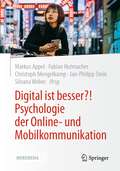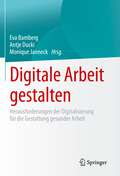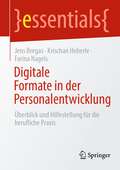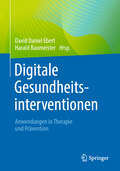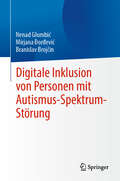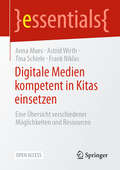- Table View
- List View
Digital Media for Learning: Theories, Processes, and Solutions
by Florence Martin Anthony Karl BetrusThis book provides a comprehensive overview on the theories, processes, and solutions relevant to effectively creating, using, and managing digital media in a variety of instructional settings. In the first section of the book, the authors provide an overview of the theories, development models, and principles of learning with digital media. In the second section, the authors detail various digital media solutions, including: Instructional Videos, Instructional Simulations and Games, Online Learning, Mobile Learning, and Emerging Learning Technologies. Overall, this book emphasizes the theoretical principles for learning with digital media and processes to design digital media solutions in various instructional settings. The readers are also provided with multiple case studies from real world projects in various instructional settings.
Digital Mental Health: A Practitioner's Guide
by Ives Cavalcante Passos Francisco Diego Rabelo-da-Ponte Flavio KapczinskiThis innovative book focuses on potential, limitations, and recommendations for the digital mental health landscape. Authors synthesize existing literature on the validity of digital health technologies, including smartphones apps, sensors, chatbots and telepsychiatry for mental health disorders. They also note that collecting real-time biological information is usually better than just collect filled-in forms, and that will also mitigate problems related to recall bias in clinical appointments. Limitations such as confidentiality, engagement and retention rates are moreover discussed. Presented in fifteen chapters, the work addresses the following questions: may smartphones and sensors provide more accurate information about patients’ symptoms between clinical appointments, which in turn avoid recall bias? Is there evidence that digital phenotyping could help in clinical decisions in mental health? Is there scientific evidence to support the use of mobile interventions in mental health? Digital Mental Health will help clinicians and researchers, especially psychiatrists and psychologists, to define measures and to determine how to test apps or usefulness, feasibility and efficacy in order to develop a consensus about reliability. These professionals will be armed with the latest evidence as well as prepared to a new age of mental health.
Digital Mental Health: The Future is Now
by Donald M. Hilty Davor MucićThe previous 2016 edition, "E-Mental Health," shed light on the application of telecommunications technologies to deliver mental health services remotely to people in often underserved locations due to geographic distance, and cultural or language differences. This new edition on "Digital mental health" represents a similar concept as e-mental health. However, the paradigm has changed; underserved populations are no longer the exclusive focus. The experience of the COVID-19 pandemic has encouraged wider acceptance and application of the technology, expanding its use to both rural and urban areas. The expansive potential of digital mental health approaches is demonstrated in a variety of mental health contexts, highlighted through clinical examples and applications that introduce innovative strategies for technology integration. Moreover, the book outlines a framework for global cooperation, with the goal of cross-border exchange of expertise and knowledge. This book targets a broad audience, including mental health practitioners, medical and nursing students, academic researchers, technology experts, and health policymakers.
Digital Music Learning Resources: From Research to Educational Practice (SpringerBriefs in Education)
by Marcella Mandanici Simone Spagnol Luca Andrea Ludovico Adriano Baratè Federico AvanziniThis book offers an overview of the complex world of digital materials for music education and of their possible use in the everyday practice of music teachers. It presents a multidimensional taxonomy of digital materials for music education. Through the taxonomy it is possible to derive a clear framework of the whole field and to perform analysis of the state of art. The book shows the use of this flexible and powerful knowledge tool for reviewing the digital materials in the various domains and dimentions. The book provides researchers and designers with an overview of what has already been designed, proposed and tested in the field. It also offers music teachers a wider perspective of the possibilities connected to current technologies in the field of music education, and it suggests possible interrelationships between research and music education practices.
Digital Orality: Vernacular Writing in Online Spaces
by Cecelia Cutler May Ahmar Soubeika BahriThis volume showcases innovative research on dialectal, vernacular, and other forms of “oral,” speech-like writing in digital spaces. The shift from a predominantly print culture to a digital culture is shaping people's identities and relationships to one another in important ways. Using examples from distinct international contexts and language varieties (kiAmu, Lebanese, Ettounsi, Shanghai Wu, Welsh English, and varieties of American English) the authors examine how people use unexpected codes, scripts, and spellings to say something about who they are or aspire to be. This book will be of particular interest to students and scholars interested in the impact of social media on language use, style, and orthography, as well as those with a broader interest in literacy, communication, language contact, and language change.
Digital Phenotyping and Mobile Sensing: New Developments in Psychoinformatics (Studies in Neuroscience, Psychology and Behavioral Economics)
by Christian Montag Harald BaumeisterThis book offers a snapshot of cutting-edge applications of mobile sensing for digital phenotyping in the field of Psychoinformatics. The respective chapters, written by authoritative researchers, cover various aspects related to the use of these technologies in health, education, and cognitive science research. They share insights both into established applications of mobile sensing (such as predicting personality or mental and behavioral health on the basis of smartphone usage patterns) and emerging trends. Machine learning and deep learning approaches are discussed, and important considerations regarding privacy risks and ethical issues are assessed. In addition to essential background information on various technologies and theoretical methods, the book also presents relevant case studies and good scientific practices, thus addressing researchers and professionals alike. To cite Thomas R. Insel, who wrote the foreword to this book: “Patients will only use digital phenotyping if it solves a problem, perhaps a digital smoke alarm that can prevent a crisis. Providers will only use digital phenotyping if it fits seamlessly into their crowded workflow. If we can earn public trust, there is every reason to be excited about this new field. Suddenly, studying human behavior at scale, over months and years, is feasible.”
Digital Phenotyping and Mobile Sensing: New Developments in Psychoinformatics (Studies in Neuroscience, Psychology and Behavioral Economics)
by Christian Montag Harald BaumeisterThis book offers a snapshot of cutting-edge applications of digital phenotyping and mobile sensing for studying human behavior and planning innovative e-healthcare interventions. The respective chapters, written by authoritative researchers, cover both theoretical perspectives and good scientific and professional practices related to the use and development of these technologies. They share novel insights into established applications of mobile sensing, such as predicting personality or mental and behavioral health on the basis of smartphone usage patterns, and highlight emerging trends, such as the use of machine learning, big data and deep learning approaches, and the combination of mobile sensing with AI and expert systems. Important issues relating to privacy and ethics are analyzed, together with selected case studies. This thoroughly revised and extended second edition provides researchers and professionals with extensive information on the latest developments in the field of digital phenotyping and mobile sensing. It gives a special emphasis to trends in diagnostics systems and AI applications, suggesting important future directions for research in public health and social sciences.
Digital Play Therapy: A Clinician’s Guide to Comfort and Competence
by Jessica StoneDigital Play Therapy focuses on the responsible integration of technology into play therapy. With a respect for the many different modalities and approaches under the play therapy umbrella, this book incorporates therapist fundamentals, play therapy tenets, and practical information for the responsible integration of digital tools into play therapy treatment. Written in a relatable manner, this book provides both the foundation and practical information for confident use of digital tools and brings play therapy, and therapy in general, forward into the 21st century. Digital Play Therapy provides a solid grounding both for clinicians who are brand new to the incorporation of digital tools as well as to those who have already begun to witness the powerful therapeutic dynamic of digital play therapy.
Digital Play Therapy: A Clinician’s Guide to Comfort and Competence
by Jessica StoneThe newly updated Digital Play Therapy focuses on the responsible integration of technology into play therapy during and after the COVID-19 pandemic. With respect for the many different modalities and approaches under the play therapy umbrella, this book incorporates therapist fundamentals, play therapy tenets, and practical information for the responsible integration of digital tools into play therapy treatment. All chapters have been updated, and new chapters discuss strategies for using teletherapy effectively during and beyond the pandemic. This revised edition provides a solid grounding both for clinicians who are brand new to the incorporation of digital tools as well as for those who have already begun to witness digital play therapy’s power.
Digital Psychology: Classification, Fields of Work and Research (essentials)
by Maren Metz Birgit SpiesThis Essential provides an initial overview of the intersections of digitalisation and psychology and outlines the developing field of digital psychology. It highlights current projects, formulates research questions and aims to stimulate discussion, action and further development.
Digital Speech Processing Using Matlab
by E. S. GopiDigital Speech Processing Using Matlab deals with digital speech pattern recognition, speech production model, speech feature extraction, and speech compression. The book is written in a manner that is suitable for beginners pursuing basic research in digital speech processing. Matlab illustrations are provided for most topics to enable better understanding of concepts. This book also deals with the basic pattern recognition techniques (illustrated with speech signals using Matlab) such as PCA, LDA, ICA, SVM, HMM, GMM, BPN, and KSOM.
Digital Storytelling for Educative Purposes: Providing an Evidence-Base for Classroom Practice (Studies in Singapore Education: Research, Innovation & Practice #1)
by Phillip Alexander Towndrow Galyna KogutThis book is an exposition of a curriculum innovation within the complex yet fertile ground of school-based education in Singapore. Beyond straightforward descriptions and protocols, this book purposefully connects classroom practices with theories in a clear, uncomplicated way. The result provides a series of rationales for action, reflection and understanding that other publications in digital storytelling sometimes fail to cover or explain in sufficient detail. Broadly, these include digital multimodal authorship; teachers’ and students’ storytelling task design and assessment; the use of digital storytelling as a reflective and reflexive expression of teachers’ professionalism; and dialogism in classroom practice.
Digital Technologies for Learning and Psychological Interventions (Integrated Science #33)
by Cristina CostescuThis book is a comprehensive guide for researchers and professionals in special education and psychology. It delves into the world of technological tools for education and intervention, empowering readers to utilize evidence-based practices. With a focus on enhancing evaluation, intervention, and learning processes for children with special needs, the book’s goal is to overcome obstacles and maximize the use of digital tools in schools. Through captivating insights and real-world applications into emerging technologies like social robots, eye-trackers, and digital applications, this book inspires professionals to embrace innovative approaches. Highlighting the potential of technology in transforming educational experiences for neurodiverse children, it offers a wealth of practical resources and knowledge. This book is an essential resource for researchers and professionals in special education and psychology, educators, psychologists, and anyone eager to leverage technology for children's development and well-being.
Digital Technologies: Sustainable Innovations for Improving Teaching and Learning
by Dirk Ifenthaler J. Michael Spector Pedro Isaías Demetrios SampsonThe aim of this volume entitled Digital Technologies: Sustainable Innovations for improving Teaching and Learning is to contribute in the global discussion on digital technologies as the means to foster sustainable educational innovations for improving the teaching, learning and assessment from K-12 to Higher Education. It compiles papers presented at the CELDA (Cognition and Exploratory Learning in the Digital Age) conference, which has as its goal continuing to address these challenges and promote the effective use of new tools and technologies to support teaching, learning and assessment. The book consists of four parts and showcases how emerging educational technologies and innovative practices have been used to address core global educational challenges; spanning from rethinking and transforming learning environments across educational contexts to effectively cultivating students’ competences for the digital smart society of the future. The book comprises Part I: Transforming the Learning Environment; Part II: Enriching student learning experiences; Part III: Measuring and Assessing Teaching and Learning with Educational Data Analytics; Part IV: Cultivating student competences for the digital Smart society. It targets researchers and research students, educational professional practitioners (including teachers, educators and education leaders) as well as education policy makers, who are interested in keeping up-to-date on the global development in this field.
Digital Technology, Eating Behaviors, and Eating Disorders
by David Šmahel Hana Macháčková Martina Šmahelová Michal Čevelíček Carlos A. Almenara Jana Holubčíková“After decades of research on dysfunctional eating and lack of physical activity, research attention has finally turned to the role of digital technology in eating behaviors and eating disorders. This timely volume offers a thoughtful and wide collection of chapters discussing the possible effects of digital technologies, from those enhancing healthy eating behaviors to those that encourage disordered eating. Highly recommended for both professionals and scholars.” Prof. Giuseppe Riva, Università Cattolica del Sacro Cuore, Milan, Italy.This book examines in depth the multifaceted roles of digital technologies in the eating behaviors and eating disorders. Coverage reflects a broad theoretical and empirical knowledge of current trends in digital technology use in health behaviors, and their risks and benefits affecting wellbeing, with focus on eating behaviors and eating disorders. The authors use both qualitative and quantitative data to focus on the digital lived experiences of people and their eating related behaviors.Among the topics covered:The quality of eating-oriented information onlineTechnology, body image, and disordered eatingEating-oriented online groupsUsing mobile technology in eating behaviorsUsage of digital technology among people with eating disordersWhat healthcare professionals should know about digital technologies and eating disordersTechnology-based prevention and treatment programs for eating disordersA potential source of discussion and debate in various fields across the social sciences, the health sciences, and psychology, Digital Technology, Eating Behaviors, and Eating Disorders will be especially useful to students, academics, researchers, and professionals working in the fields of eating behaviors and eating disorders.
Digital Therapy: The New Age of Healthcare
by Laure BeyalaDigital Therapy: The New Age of Healthcare
Digital Transformation and Disruption of Higher Education
by Andreas KaplanThis book analyses higher education's digital transformation and potential disruption from a holistic point of view, providing a balanced and critical account from a variety of interdisciplinary viewpoints. It looks at case studies on educational and emerging technology, their impact, the potential risk of digitalization disrupting higher education, and also offers a glimpse into what the future of digitalization will likely bring. Researchers and practitioners from countries including New Zealand, Russia, Eswatini, India, and the USA, bring together their knowledge and understanding of this rapidly evolving field. The contributors analyse academia's digitalization along the broad topics of the sector's general digital (r)evolution. The book looks at changes in instructional formats from the Massive Open Online Courses to Small Private Online Courses and artificial intelligence. This work also provides analysis on how skills, competences and social networks demanded by future jobs and job markets can be further integrated into higher education.
Digital Youth
by Kaveri Subrahmanyam David SmahelYouth around the world are fittingly described as digital natives because of their comfort and skill with technological hardware and content. Recent studies indicate that an overwhelming majority of children and teenagers use the Internet, cell phones, and other mobile devices. Equipped with familiarity and unprecedented access, it is no wonder that adolescents consume, create, and share copious amounts of content. But is there a cost? Digital Youth: The Role of Media in Development recognizes the important role of digital tools in the lives of teenagers and presents both the risks and benefits of these new interactive technologies. From social networking to instant messaging to text messaging, the authors create an informative and relevant guidebook that goes beyond description to include developmental theory and implications. Also woven throughout the book is an international sensitivity and understanding that clarifies how, despite the widespread popularity of digital communication, technology use varies between groups globally. Other specific topics addressed include: Sexuality on the Internet.Online identity and self-presentation.Morality, ethics, and civic engagement.Technology and health.Violence, cyberbullying, and victimization.Excessive Internet use and addictive behavior. This comprehensive volume is a must-have reference for researchers, clinicians, and graduate students across such disciplines as developmental/clinical child/school psychology, social psychology, media psychology, medical and allied health professions, education, and social work.
Digital ist besser?! Psychologie der Online- und Mobilkommunikation
by Markus Appel Fabian Hutmacher Christoph Mengelkamp Jan-Philipp Stein Silvana WeberMacht das digitale Zeitalter unser Leben besser, komplizierter oder vielleicht beides zugleich? Welche Chancen und Risiken sind mit Internet und Smartphone verbunden?Diese Einführung in die Psychologie der Online- und Mobilkommunikation widmet sich verschiedenen Bereichen der digitalen Kommunikation, die in unserem Alltag eine zentrale Rolle spielen, u.a.:· Social Media, Onlinedating und digitalen Lernumwelten· Fake News, Verschwörungstheorien· Cyberbullying (Cybermobbing) · Roboter, virtuelle Realitäten· Künstliche Intelligenz.Die anschaulichen und fundierten Beiträge wurden allesamt von Expert:innen verfasst und bieten eine aktuelle und umfassende Informationsgrundlage. Im Zentrum stehen dabei wissenschaftlich fundierte Erkenntnisse, die mitunter überraschen dürften. Mit Fragen und Antworten online sowie Zusatzmaterial über die Lehrbuch-Begleitwebsite. Mit Geleitworten von Prof. Dr. Bernad Batinic (JKU Linz) und Jasmina Neudecker (bekannt aus TerraX).
Digitale Arbeit gestalten: Herausforderungen der Digitalisierung für die Gestaltung gesunder Arbeit
by Eva Bamberg Monique Janneck Antje DuckiZu betrieblicher Gesundheitsförderung und zu Gesundheitsmanagement liegen zahlreiche Veröffentlichungen vor. Es fehlen jedoch Publikationen, in denen aktuelle Entwicklungen des Arbeitslebens, besonders Digitalisierung, hinreichend berücksichtigt werden. Digitalisierung hat für Gesundheit und für Gesundheitsförderung eine doppelte Relevanz: Sie verändert das Arbeitsleben und dabei Arbeitsverhältnisse, Arbeitsorganisation und Arbeitsbedingungen, und sie beeinflusst Methoden und Instrumente der Gesundheitsförderung. Dieser Band gibt praktisch nützliche und wissenschaftlich fundierte Handlungshilfen für gesundheitsbezogene Maßnahmen in der digitalisierten Arbeitswelt. Zentrale Entwicklungen der Arbeitswelt sowie digital gestützte Methoden der Gesundheitsförderung werden dargestellt und diskutiert.
Digitale Formate in der Personalentwicklung: Überblick und Hilfestellung für die berufliche Praxis (essentials)
by Krischan Heberle Jens Bregas Farina NagelsDas durch die Pandemie veränderte Arbeiten hat auch die Personalentwicklung veranlasst, ihre Methoden und Arbeitsweisen umzustellen. Digitalisierung bietet sich seitdem als Lösung für viele Fragestellungen an. In diesem essentials-Band werden daher exemplarisch drei Themengebiete der Personalentwicklung (Eignungsdiagnostik, Teamentwicklung und Führungskräfteentwicklung) als digitale Varianten vorgestellt, die in der Corona-Krise relativ kurzfristig umgesetzt wurden. Damit richtet sich dieser Band an Praktiker, die Anknüpfungspunkte für die eigene Digitalisierung ihrer Entwicklungsarbeit suchen und Hindernisse umgehen möchten oder ihr bisheriges Vorgehen mit anderen abgleichen wollen.
Digitale Gamebooks in der Bildung: Spielerisch Lehren Und Lernen Mit Interaktiven Stories
by Bodo Möslein-Tröppner Willi BernhardSerious Games und spielerisches Lernen erfreuen sich im Bildungsbereich einer immer größeren Nachfrage. Dies ist nicht verwunderlich, schließlich praktizieren alle Menschen das Spiel in unterschiedlichen Weisen gleich von Geburt an. Wir wissen heute, dass Spielen eine der effektivsten Lernformen ist.Kollaborative digitale Gamebooks ermöglichen es, als Lehrpersonen auf eine solche Nachfrage zu reagieren, ohne externe Spieldesigner und Software-Entwickler herbeiziehen zu müssen. Inhaltlich können sie damit ihre eigenen Wissensgebiete in Eigenregie spielerisch, didaktisch und technisch aufbereiten, wobei das Spielgeschehen nur durch ihre eigenen Ideen begrenzt ist und nicht etwa durch technische Gegebenheiten. Beim kollaborativen Gamebook handelt es sich um ein digitales interaktives Spiel bei dem in der kompletten Spielumgebung durch Textkomponenten ein Vorstellungsbild im Kopf des Spielers erzeugt wird – wie bei einem Buch. Der Leser (= der Lernende) nimmt die Rolle des Spielers ein und kann dabei direkten Einfluss auf die Handlung des Geschehens nehmen. Im Spielverlauf stößt er immer wieder auf andere Spieler, mit denen er kollaborieren muss, um vorwärts zu kommen. Die Handlungen im Spiel können vom Lernenden direkt beeinflusst werden. Auf diese Weise wird Wissen spielerisch erfahren, motivierend erlernt und praktisch angewendet.In diesem Buch wird erstmals das neue Format des Gamebooks für den Unterricht im Game-based-learning-Kontext an (Hoch-)Schulen vorgestellt. Die Integration spielerischer, kollaborativer Elemente sowie das Konzept der Selbstwirksamkeit im Bildungskontext ist weltweit einzigartig. Die Erstellung des kollaborativen digitalen Gamebooks ist direkt durch die Lehrperson möglich; Informatiker und Gameentwickler werden nicht benötigt.
Digitale Gesundheitsinterventionen: Anwendungen in Therapie und Prävention
by Harald Baumeister David Daniel EbertDie Aufklärung von Patienten erfolgt mittlerweile selbstverständlich unter Nutzung des Internets. Auch Behandlungen und Beratungen sind zunehmend online möglich. Dieses Buch zeigt die Möglichkeiten digitaler Gesundheitsinterventionen bei psychischen Störungen wie z.B. Angst- und Suchtstörungen, Demenz sowie bei körperlichen Erkrankungen wie Diabetes mellitus, Tumor- und Schmerzerkrankungen. Ein weiterer Schwerpunkt liegt im Einsatz bei Gesundheits- und Risikoverhaltensweisen, wie Stressmanagement, Raucherentwöhnung oder Ernährung. Es zeigt wie Notebook, Smartphone und Wearable genutzt werden können, wie sie wirken und wo sie eingesetzt werden können, z.B. in der Prävention, der betrieblichen Gesundheitsförderung, der Akutversorgung oder der Rehabilitation. Das Werk wendet sich an alle Ärzte, Psychotherapeuten und Psychologen, die moderne Medien zur Behandlung ihrer Patienten einsetzen und die Prinzipien verstehen möchten.
Digitale Inklusion von Personen mit Autismus-Spektrum-Störung
by Nenad Glumbić Mirjana Đorđević Branislav BrojčinDieses Buch untersucht Chancen und Hindernisse für die digitale Inklusion von Personen mit Autismus-Spektrum-Störung (ASS). Es behandelt die grundlegenden Anforderungen der „digitalen Gesellschaft“ sowie Konzepte der digitalen Inklusion (und Exklusion), der digitalen Teilhabe und der digitalen Kluft bei Behinderungen und bietet Unterstützung für Personen mit Autismus bei der Mitgestaltung digitaler Geräte. Das Buch diskutiert die Anwendung digitaler Technologien in verschiedenen Kontexten, einschließlich Bildung, Freizeitaktivitäten, Gemeinschaftsleben, alltäglichen Lebensfähigkeiten und Beschäftigung von Personen mit Autismus. Behandelte Bereiche umfassen: Computerbasierte Interventionen zur Sprachentwicklung, sozialen Kommunikation, exekutiven Funktionen und anderen Fähigkeiten bei Kindern mit Autismus. Digitale Gesundheitsinterventionen für Personen mit ASS. Risiken für Personen mit ASS im Internet (z.B. übermäßige Nutzung, süchtiges Verhalten und Cybermobbing). Nutzung digitaler Technologien zur Simulation von Vorstellungsgesprächen und zur Vermittlung von Arbeitsfähigkeiten. Nutzung digitaler Technologien in Selbstvertretungsaktivitäten von Personen mit Autismus. Digitale Inklusion von Personen mit Autismus-Spektrum-Störung ist ein unverzichtbares Nachschlagewerk für ForscherInnen, ProfessorInnen, DoktorandInnen, KlinikerInnen sowie verwandte TherapeutInnen und Fachleute in der klinischen Kinder- und Schulpsychologie, der Sozialarbeit, der Verhaltenstherapie/Rehabilitation, der Pädiatrie, der Physiotherapie, der Ergotherapie, der Sprachtherapie, der Neurologie, der Sonderpädagogik, der Kinder- und Jugendpsychiatrie sowie der Entwicklungspsychologie.
Digitale Medien kompetent in Kitas einsetzen: Eine Übersicht verschiedener Möglichkeiten und Ressourcen (essentials)
by Frank Niklas Anna Mues Astrid Wirth Tina SchieleDigitale Medien sind fester Bestandteil der Lebenswelt von Kindern und der frühpädagogischen Arbeit. Das frühe Erlernen von Medienkompetenzen, die Professionalisierung pädagogischer Fachkräfte und qualitativ hochwertige medienpädagogische Arbeit sind deshalb von zentraler Bedeutung. Dieses Open Access essential zur digitalen Medienbildung bietet wissenschaftlich fundierte Informationen und praktische Anwendungen für den Einsatz von Tablets und Apps mit jungen Kindern. Dabei werden konkrete Ideen sowie spielerische und kindgerechte Praxis-Tipps vermittelt.
